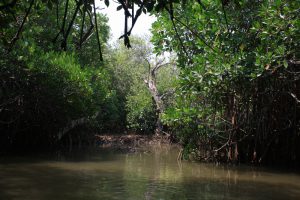
By Rituparna Borah
The sight of a family of seals staring back at me, through the patchy openings of a thick mangrove forest, with their round and gullible yet inquisitive eyes, was incredibly delightful. At least for those rare moments, I was delivered from my certainty of a distinctive existence to that of one where I might be the alien instead: unfamiliar and ready to be accused of trespassing or experimented upon! Thankfully the population of these curious seals is way too less to be a threat to us humans- the constantly burgeoning mass- on the surface of the earth. We- my friend, the boatman and I- travelled for some distance, rowing through a narrow waterway between two mangrove islands and them-the family of seals- travelled parallel to our route through the forests on our right. To listen to the squeaks of the little seals was another delight, and I asked the boatman to row the boat closer to the forests.
 The head of one seal: My reflexes aren’t good enough to capture “the” moment; it usually passes by
The head of one seal: My reflexes aren’t good enough to capture “the” moment; it usually passes by
the time I recover from my awe and remember that I need to capture it, nor was my camera pro enough to
capture telephoto shots. Hence, the pointer to help find the main object of my focus.
Pichavaram is the first mangrove forest I have seen closely in my life. The boatman- a robust Tamil fellow in his early twenties perhaps- told us that the mangroves are not only home to the seals, the fascinating migratory birds, the fishes, and crabs but also the only major livelihood alternative to farming for the villagers. They have shaped the lives of the villagers as much as they have for the estuarine biome. If it were not for the mangroves, there would have been irredeemable damage to the villages of the region during the devastating Tsunami on 26th of December, 2004 that ruined many coastal areas in South-east Asia beyond recognition.
What makes it a wonder:
At some places, as we rowed, the route turned pitch dark, the prop roots and branches of the relatively short Rhizophora trees hung over us and some prop roots protruded lower near the ground to interweave with their neighbours, creating some forbidding motifs, all of which reminded me of fictions and movies plotted in the Amazon rainforests and the like: eerie! Numerous unfamiliar small insects and butterflies abounded these zones. Now and then, I spotted small crabs crawling on the roots as well.
 A tiny crab
A tiny crab
However, silence is no stranger to me and to anyone who’s familiar with nature’s
language; this one didn’t speak of dangers but of the harmlessness: of the peace and self-sufficiency of the biotope. The darkness, the carefree inhabitants and the silence gestured that they didn’t need any human intervention to survive, nor did they like the frequent intrusions.
Here, I would like to make an observation: as we forded ahead, we came across a couple of other boats with tourists loud enough to frighten the whole forest. Quite frankly, this is what I dislike about Indian tourism: that it has no regulations corresponding to the natural ambiance of a place. There’s probably no one on earth who likes visitors creeping into one’s house, intervening with his/her ways, disturbing the privacy; similar is the case with a particular sphere of nature and its inhabitants. It’s my appeal to all prospective visitors of Pichavaram, who, if/when, inspired by this write-up of mine or someone else’s, visits the place, to bear the necessary respect for the silence of the kind in Pichavaram. It won’t take one much time to realize that the silence itself whispers not to be disturbed.
My friend and I visited Pichavaram on a whim. We hadn’t planned and hence we knew little about what we were going to encounter. Thanks to our boatman, who kept enlightening us in the utterly musical but perplexing language: Tamil, leaving us at the mercy of the English words he had to resort to, we came to know lot more about the place than we were expecting.
 Our boatman
Our boatman
Spreading over more than 3000 acres, according to our boatman, Pichavaram is one of the largest mangrove wetland ecosystems in India, situated at the mouth of the Vellar, Coleroon and Uppanar rivers in the district of Cuddalore in Tamil Nadu. Not far from the bustling temple town of Chidambaram, the quaint coastal villages of the Pichavaram biotope thrives economically on farming, small scale fishery, and recently on neo-modern activities like ecotourism, sustainable aquaculture and crab fattening, while their culture and customs have been largely moulded by tribal ways backed by the forest resources and the mangrove ecosystem. Traditionally, from timber requirements for fuel to fodder, food and medicinal plants, everything was derived from the mangroves. The proof of that we witnessed as we waded through the waters: now and then a boat would pass us by, carrying fishing gears like cast nets and gill nets and the boatmen and fishermen would share a joke or a concern, and in turn laugh or frown between themselves depending on what had been shared. Naturally, we sat clueless, being reminded once again that we were outsiders who could only observe a life different from their own, but not participate. We also came across many crab traps on our way: a nylon bag trap suspended in the water, attached to a white box floating on the water, which resembled the mechanism of the more sophisticated crab pots and floats.

On clearer zones, where sunlight streamed in through less dense mangroves, I occasionally spotted a black-winged stilt or a painted stork. Herons, egrets, and storks roamed about liberally: as if the sky above the mangrove was theirs to claim, not to mention the forests as well; as if the water is indebted to them and hence fed them whenever they wished. I actually spotted a stone curlew bird, which is supposedly uncommon in that area and its behaviour said that it’s not very confident about its right to the water and the land, nevertheless it definitely felt safe. And yes, it is this vibe I received from the behaviour of the fauna that they feel easy, safe and at home that mostly kept me mesmerized throughout the journey.
 An egret
An egret
Of course, the mangroves in themselves are a sight to see. From a distance, they appear as some islands of forbidding sacred groves of shrubs. As one travels closer, the natural waterways definitely make one feel welcome until he/she reaches the denser part, where as I said before, the silence is all engulfing. In short, for someone who establishes a deep connection with nature, these mangroves usher novel emotions. For someone interested in biodiversity in general or botany specifically, some Rhizophora species in Pichavaram might kick off the curiosity, because they seem to be something in between Rhizophora mucronata and Rhizophora apiculata, and given my limited knowledge I suspect if such a species exists or breeds naturally. Nonetheless, if it does, it must be preserved, so as not to lose a valuable natural asset of this country.

 The mangroves and inhabitants on its peripheries
The mangroves and inhabitants on its peripheries


Observations on the Eco-tourism industry in Pichavaram:

For an area, which claims to have been benefitted economically by the tourism industry and other neo-modern activities, Pichavaram looked rather poverty ridden to me. No doubt the overall development in Tamil Nadu, especially in the sector of transport and communication is commendable. For instance, the road to as remote a place as Pichavaram is comfortably commutable, compared to similar regions in most North and North-Eastern states of India. Yet, one look at the state of houses and farmlands is enough to comprehend the actual state of the economy of that region. We were informed that the tourism industry is hardly doing any good to the community directly, except for employing a few youth and elderly men, from landless households. Although the pressure on mangroves for fodder, timber, and other injudicious uses has considerably decreased over the years, which I suppose is because of the rising awareness and organizational initiatives to conserve nature, the mangroves are still affected by overall climatic changes, like most other mangroves in the world, and by excessive grazing of cattle on their sidelines.



I would like to put forth another observation: despite the very best initiatives of the government and non-governmental organizations, the potential of the natural resources of this area have not been utilized fully, sensibly and economically. Eco-tourism is based on the idea that there should be a balance between ecological and economic sustenance, and in cases where some compromise has to be made should be necessary on the economic front than on the ecological, because in the long run, such a compromise would serve lesser harm than in a case otherwise. Our boatman confirmed that 300 tourists visit the place every day on an average, which culminates into an average of 9000 tourists every month. Where does the revenue from the tourism flow then, since it is apparent that the locals are not getting a major share of it? Is there enough transparency in the ecotourism management in India? These are some questions, which need be addressed soon.
Any eco-tourism initiative, by its very principle, is forwarded towards the self-sufficiency of a community, rather than earning profits for the nation as a whole. Only if a region has achieved a growth-rate at par with or higher than the growth-rate of neighbouring regions, that it is eligible and liable to help its neighbouring regions and the nation. It has been mentioned in the revered Hindu scripture ‘Gita’ that one must help oneself before turning on to help others. Every time we board a flight we are advised to put on our own oxygen masks in case of an emergency, before helping others put it on. Similarly, any initiative taken in the name of local development must never be used by the state for other benefits but the benefit of that and only that region, until it reaches the point of self-sustenance it aims to achieve. In my opinion, any eco-tourism initiative, by virtue of being different in principle from cultural/heritage tourism, adventure tourism, pilgrimage tourism and others, must have strict regulations like prior booking, limiting entry in a day, putting forth instructions of proper conduct etc. While other forms of tourism are not likely to affect nature or the ways of an indigenous community, unregulated tourism in ecologically significant and endangered areas might cause the very harm it sets out to avoid under the banner of ‘ecotourism’.
Tailpiece:
Pichavaram mangroves is a dark green estuarine landscape, with tidal inlets and channels, where diverse ecosystems have merged to give life to one single unit; where seas have met rivers and the lands, and where mud-flats coexist with sand-flats. It is home to such a rich biodiversity as one can only imagine and is the lifeline of the villagers of the region. For someone who has never experienced absolute silence, Pichavaram is the place to have a dip in it. I hope that in future the government, the researchers, NGOs and the locals will come together to devise such economic activities which pose the least harm to this richness of nature and at the same time help the indigenous people nurture an economy that not only helps in self-sustenance but produces surplus as well in the long run.



Brief Bio: Rituparna Borah is a research fellow at Madras Institute of Development Studies (MIDS), Chennai where she is pursuing research on ecotourism. Her areas of research include political ecology, natural resources management, and community participation. Apart from these, cinema, cultural studies, and Indian philosophy also appeals her.
(The article first appeared on Halfnotes. To read the original article click Here.)


















